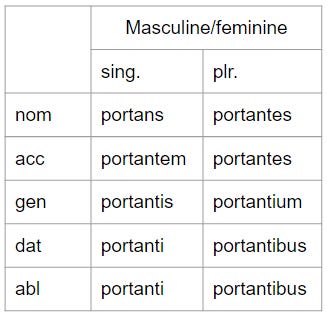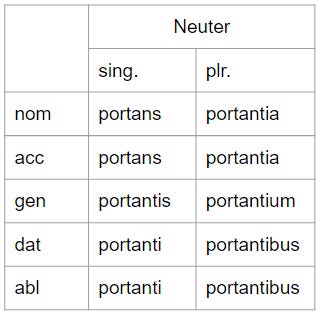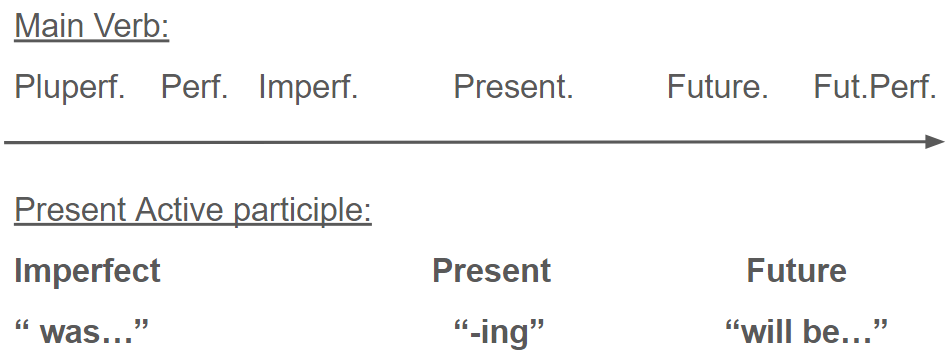Present Active Participles
Dipping a toe into participles in Latin
Welcome back! Today we’re looking at present active participles in Latin.
Because I'm talking about participles, you're going to really need to know your noun endings today. So if you're not sure about any of those, go and download my free noun endings reference guide here. It has all the endings for first, second, and third declension on there.
What is a participle?
It's what's called a verbal adjective. It has two different parts:
The verbal side. All that means is that it's formed from a verb.
The adjective part means it declines like an adjective.
Because a participle is formed from a verb, that means it has a tense, like a verb, and a voice (active or passive). Today we're going to look at active participles. My next post will look at passive participles, so make sure you’re subscribed to get that!
Because it's like an adjective, it has a number, a gender, and a case.
There are several types of participle in Latin. Here is a quick summary:
present active participle: “carrying”
Example: the man carrying the books.
perfect passive participle: “having been carried”
Example: he put down the having been carried books.
future active participle: “about to carry”, or “being about to carry”.
Example: being about to carry the books, he stretched his arms.
perfect active participle: “having spoken”.
These are only for deponent verbs
Each of these will have a post, so make sure you’re signed up to get those straight to your inbox. Today, I am focused on the first: Present Active Participles.
What you need to know
They are formed from the present active infinitive. That's your second principal part in your dictionary if you're looking at your verb lists.
It matches the noun it's describing in case, number and gender. That is just like adjectives.
Present active participles decline like a third declension noun. If you're not sure about 3-3 adjectives, you can find my post about them here. For 3-3 adjectives, masculine and feminine nouns use the same ending for their participles, there’s no difference between them. However, neuter has a separate table of endings. You only have two to have a look at, but you need to know there is a difference.
What are they for?
Present active participles describe an action taking place at the same time as the main verb. I'll get into what that means for translating in a minute.
The good thing about present active participles is they're really easy to spot. You either have -ns at the end of the participle in the nominative and sometimes accusative singular, or you have -nt- before the case ending. I like to tell people to remember -NT- because it's like present.
Forming Present Active Participles
Take the present active infinitive. portare: to carry.
Take off -re, the bit that makes it an infinitive, and you are left with the present active stem. porta-
Then add these endings, depending on the gender and case of the noun it is describing.
These are the endings I'd expect for an adjective like ingens. As you can see, the neuter endings are quite similar to the masculine/feminine endings, but there are some differences, like the accusative singular being portans again, not portantem, and the nominative and accusative plural being portantia. Again, that's a bit like ingens.
Here’s an example:
per villam ambulans puellam vidi.
To start with, I recognise immediately that ambulans is my present active participle because of that -ns ending which is so unusual in Latin.
What do we know about this participle? It could be nominative masculine/feminine singular. But it could also be the nominative or accusative neuter singular.
How do we tell which it is? The first thing you should always do is check the verb. vidi means “I saw”. Now the subject of this verb is unlikely to be something that's neuter, as it’s most likely a person that is speaking. So let’s rule out neuter nominative for now. But it could still be neuter accusative.
Let's look at the accusatives. We have villam and puellam. Again, neither of those are neuter. They're both feminine. So ambulans can’t be using a neuter ending, as it has to match the gender of the noun it describes. So we’re going to just completely remove the option that means it's neuter. This means it's nominative, masculine or feminine.
It doesn't really matter what the gender is in this case, because it's just “I”. It's describing the same person who's doing the seeing. So “I saw” something, “while walking”.
Because it's a present active participle, we also know that it's happening at the same time as the main verb. The main verb is vidi, which is in the perfect tense. The participle therefore is happening in effectively the past. Because it's a present active participle, it matches the tense of the main verb.
So let's have a go at translating it.
vidi, “I saw”
puellam means “the girl”
per villam ambulans: ambulans can't be describing the girl. She's not walking anywhere, because she is accusative, and ambulans must be nominative (as we deduced from above). So it must be describing the “I” of the sentence, who is doing the action.
So we could translate this as “walking through the house, I saw the girl”. That is perfectly fine. Full marks. But it's a little bit clunky, so you could (if you wanted to) change your translation slightly:
“While I was walking through the house, I saw the girl”
Because the participle is happening at the same time as the main verb, we can use a temporal word like “while” or “as” to help make sure that the reader understands it’s a present active participle. In English, in order to get the present active participle to be happening at the same time, we use the continuous action in the past which is also called the imperfect tense. So we can translate present active participles in the imperfect tense if the main verb is perfect, purely because of something called the sequence of tenses.
Don't worry too much about it. Just make your translation sound fluent.
Sequence of Tenses
Look at this diagram:
Main verbs have three main categories:
The past tenses: pluperfect, perfect, and imperfect.
The present tense.
The future tenses: simple future and future perfect
Each of these categories has a different role to play if there is a present active participle. Because the present active participle has to happen at the same time as the main verb, if the main verb is in one of the past tenses, the present active participle is translated as an imperfect, like in the sentence above: “while I was walking”.
If the main verb is present, it usually translates as “-ing”, such as “walking”. It doesn’t need a past tense or a future tense, because the main verb is in the present tense.
If the sentence has a future tense main verb, then the present active participle goes into the future, because it's happening at the same time. This would be “while I will be walking”.
All the sequence of tenses means is that the present active participle must match the tense of the main verb. That's it. It takes the tense like a little sponge. It has to latch onto the tense of the main verb and change accordingly.
Some examples:
Present main verb:
lacrimantem feminam video - I see the crying woman.
Literally, “I see the woman who is crying”. Present main verb, present participle.
Past main verb:
lacrimantem feminam vidi - I saw the crying woman.
vidi is a perfect tense. You can just translate it like that, that's fine, but literally it should be “I saw the woman who was crying”. It’s taken a step backwards, into the imperfect, because the main verb is perfect.
Future main verb:
lacrimantem feminam videbo - I will see the crying woman
Literally: “I will see the woman who will be crying”. Again, you don't need to do that, the fluent translation is fine. But just in case you're wondering, that’s why the present active participle works, and as you get a bit further along you need to know these things for more difficult grammar.
Waving goodbye
That’s all you need for Present Active Participles. Remember you need your present active stem, which you get from taking the -re off the infinitive, and then you add the endings, as I've shown above, which are your 3-3 adjective endings.
I hope this has been useful to you and you've learned something about present active participles. Let me know what you thought in the comments.
Thank you so much for reading, and I'll see you next time on bambasbat!




